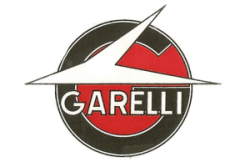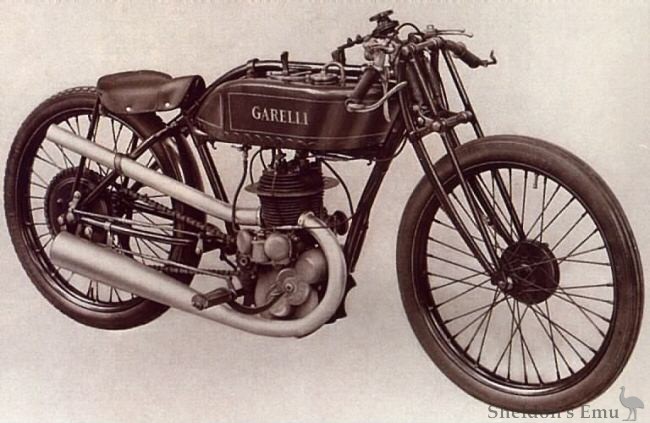



1924 Garelli GP 350 cc
La marca Garelli está asociada a los ciclomotores y motocicletas de baja cilindrada o al micromotor Garelli Mosquito que se comercializó masivamente luego de la Segunda Guerra Mundial. También es conocido por nosotros, los argentinos, por el viaje que hizo Ernesto "Che" Guevara cuando recorrió 12 provincias argentinas haciendo mas de 4000 kilómetros en una bicicleta con un motor Micrón-Garelli, sin embargo los comienzos de la firma fundada por Adalberto Garelli se remontan a la década del ´10.
El ingeniero Garelli diseña en 1912 un motor de dos tiempos con "cilindro partido" y doble pistón (técnica aplicada una década después por Puch). Este motor presentaba dos pistones en paralelo accionados por una sola biela y un único perno de pistón en común mientras que los dos cilindros fundidos en un mismo bloque formaban una sola cámara de combustión compartida. Los cilindros separados estaban dispuestos de modo que uno era responsable de la carrera de admisión y de escape y el otro del barrido. Bajo esta disposición los gases de admisión y de escape estaban mejor separados y no era necesario que los pistones tuvieran deflector (algo muy utilizado en esa época y propensos al sobrecalentamiento). De ese modo se mejoraba la potencia de salida y el consumo de combustible.
En 1914 Garelli construye una motocicleta prototipo de 350 cc y para demostrar su confiabilidad el propio ingeniero ascenderá a Moncenisio (un paso en los Alpes a más de 1900 msnm).
En 1919 funda Garelli Motociclette. La primera motocicleta en producción es la versión definitiva del anterior "350". Inicialmente estará disponible en dos versiones: la "Normale da Turismo" y la "Raid Nord-Sud" en conmemoración de la primer carrera de larga distancia ganada por el piloto Ettore Girardi cuando recorrió 840 km por caminos prácticamente intransitables entre Milán y Nápoles a una velocidad media de 38 Km/h a bordo de una 350.
Otro diseño patentado por Garelli fue la construcción del motor en una unidad tipo Monobloc donde los carteres tenían incorporado un alojamiento para el magneto y otro para la caja de dos velocidades con un embrague multidisco, haciendo todo el conjunto muy compacto y protegido del agua y del polvo.
Las Garelli de carreras fueron las primeras en ser equipadas con un tanque de aceite para la lubricación del motor por separado. El aceite se mezclaba automáticamente con el combustible en una proporción dada por el ajuste del acelerador. Otro hito en la tecnología de dos tiempos fue el uso de un caño de escape con cámara de expansión para incrementar la potencia. Todas estas innovaciones hicieron que las Garelli, junto con las Scott, fueran las únicas motos de dos tiempos que podían dar competencia a los cuatro tiempos contemporáneos.
En 1921 la Garelli 350cc gana la primera edición del Circuito del Lario, considerado el "TT italiano".
En 1922 Garelli hace el 1-2-3 en el Gran Premio de Estrasburgo (la primera vez que una moto italiana ganaba fuera de su país) y también gana el primer GP de las Naciones (Monza) en 1922 con Ernesto Gnesa a 100,5 Km/h, superando a otras motos de 500 cc.
En 1923 Achille Varzi logra el Campeonato Italiano ganando la totalidad de las 10 carreras.
Además de participar en las carreras, Garelli promocionaba sus motos intentando batir récords de velocidad: en 1923, en el circuito de Monza, Garelli obtuvo 76 récords mundiales principalmente sobre largas distancias y tiempos de hasta 12 horas.
En 1926 la última versión de carrera de la Garelli 350 desarrollaba 20 HP a 4500 rpm y alcanzaba los 140 km/h.
The Garelli name is associated with low displacement mopeds and motorcycles or the Garelli Mosquito micromotor that was massively commercialized after the Second World War. It is also known in Argentina (from whence the author hails) for the trip that Ernesto "Che" Guevara made when he toured 12 Argentine provinces doing more than 4000 kilometers on a bicycle powered by a Micrón-Garelli engine. However the history of the firm founded by Adalberto Garelli dates back to the early 20th century.
The engineer Garelli designed in 1912 a two-stroke engine with "split cylinder" and double piston (technique applied a decade later by Puch). This engine had two pistons in parallel driven by a single connecting rod and a single piston pin in common while the two cylinders fused in a single block formed a single shared combustion chamber. The separate cylinders were arranged so that one was responsible for the intake and exhaust stroke and the other for the sweep. Under this arrangement the intake and exhaust gases were better separated and it was not necessary for the pistons to have deflector (something commonly used at that time and prone to overheating). This improved the power output and reduced fuel consumption.
In 1914 Adalberto Garelli built a 350 cc prototype motorcycle and to demonstrate its reliability the engineer ascended the Moncenisio Pass, a climb of more than 1900 metres, in treacherous conditions on what then was little more than a goat track. He was the first motorcyclist to achieve the task. [1]
In 1919 he founded Garelli Motociclette. The first motorcycle produced, developed from the original 350, was initially available in two versions: the Normale da Turismo and the North-South Raid, respectively capable of achieving 80 and 120 km/h. The Raid commemorates the first long distance race won by Ettore Girardi when he rode 840 km on practically impassable roads between Milan and Naples at a average speed of 38 km/h piloting a 350.
Another design patented by Garelli was a unit construction (monobloc) engine with the casings housing both the magneto and the two-speed gearbox with a multi-plate clutch, achieving a very compact design protected from water and grime.
The Garelli racing machines were the first to be equipped with a separate oil tank for engine lubrication. The oil was automatically mixed with the fuel in a proportion given by the throttle setting. Another milestone in two-stroke technology was the use of an exhaust pipe with expansion chamber to increase power.
All these innovations made the Garelli one of only two two-stroke motorcycles which could compete with the contemporary four-strokes. The other was the Scott.
In 1921 a 350cc Garelli won the first Circuito del Lario event, considered the "Italian TT".
In 1922 Garelli took first, second and third at the Strasbourg Grand Prix (the first time an Italian motorcycle won outside Italy) and also won the first International GP (Monza) in 1922 with Ernesto Gnesa at 100.5 km/h, beating the 500cc competition.
In 1923 Achille Varzi took the Italian Championship winning all 10 races.
Besides participating in the races, Garelli promoted his marque with speed record assaults: in 1923, at the Monza circuit, Garelli won 76 world records. These were mostly long distance events with durations of up to 12 hours.
In 1926 the final version version of the racing Garelli 350 developed 20 HP at 4500 rpm and reached 140 km/h.
Source: Sergio Scalerandi
Notes:
1. Mick Walker's Italian Racing Motorcycles, p96; icenicam.org.uk